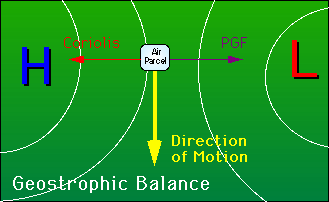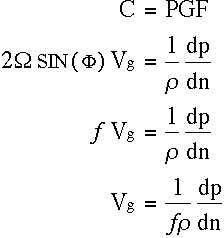

Notice that the direction of motion is exactly parallel to the isobars, with high pressure on the right and lower pressure on the left. Upper level winds flow approximately geostrophically. The geostrophic wind (Vg) is a close approximation of the real wind (V). It is important to remember that as the air parcel moves, the Coriolis and PGF will change (as latitude and pressure change), and so a possible acceleration or deceleration could result.
Mathematically, let's see how Vg is calculated. If we equate the PGF and Coriolis force, then we can solve for Vg, which in this case replaces the actual wind (V), previously used in the Coriolis equation.

Vg is simply the pressure gradient force divided by the Coriolis parameter.
Keep this in mind: the geostrophic wind is a theoretical wind that is often used to describe actual wind flow aloft. The theoretical geostrophic wind is sometimes the same as the actual wind. However, the only way to get values for the actual wind is to measure it with vanes, profilers and the like.
The geostrophic wind is not always uniform throughout a layer. The change in Vg with height gives us the thermal wind.
 The Shodor
Education Foundation, Inc.
The Shodor
Education Foundation, Inc.